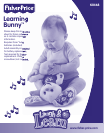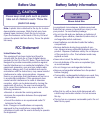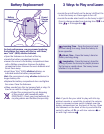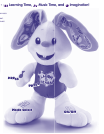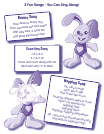
1.5V x 3
“AAA” (LR03)
Shown Actual Size
In exceptional circumstances, batteries may leak
fluids that can cause a chemical burn injury or ruin
your product. To avoid battery leakage:
• Do not mix old and new batteries or batteries of
different types: alkaline, standard (carbon-zinc) or
rechargeable (nickel-cadmium).
• Insert batteries as indicated inside the battery
compartment.
• Remove batteries during long periods of non-
use. Always remove exhausted batteries from the
product. Dispose of batteries safely. Do not dispose
of this product in a fire. The batteries inside may
explode or leak.
• Never short-circuit the battery terminals.
• Use only batteries of the same or equivalent type,
as recommended.
• Do not charge non-rechargeable batteries.
• Remove rechargeable batteries from the product
before charging.
• If removable, rechargeable batteries are used, they
are only to be charged under adult supervision.
Battery Safety Information
Care
• Wipe this toy with a clean cloth dampened with
a mild soap and water solution. Do not immerse
this toy.
• This toy has no consumer serviceable parts. Do not
take this toy apart.
Before Use
Please keep small parts such as plastic
tabs out of children’s reach. Throw the
plastic tab away.
Note: A plastic tab is attached to the toy for in-store
demonstration purposes. While the tab may have
already been removed, check the toy to be sure.
Open the fasteners on the back of the toy. Pull and
remove the plastic tab from the toy. Throw the plastic
tab away.
CAUTION
FCC Statement
United States Only
This equipment has been tested and found to
comply with the limits for a Class B digital device,
pursuant to Part 15 of the FCC Rules. These limits are
designed to provide reasonable protection against
harmful interference in a residential installation. This
equipment generates, uses and can radiate radio
frequency energy and, if not installed and used in
accordance with the instructions, may cause harmful
interference to radio communications. However,
there is no guarantee that interference will not occur
in a particular installation. If this equipment does
cause harmful interference to radio or television
reception, which can be determined by turning the
equipment off and on, the user is encouraged to
try to correct the interference by one or more of the
following measures:
• Reorient or relocate the receiving antenna.
• Increase the separation between the equipment
and receiver.
• Consult the dealer or an experienced radio/TV
technician for help.
Note: Changes or modifications not expressly
approved by the manufacturer responsible for
compliance could void the user’s authority to operate
the equipment.



